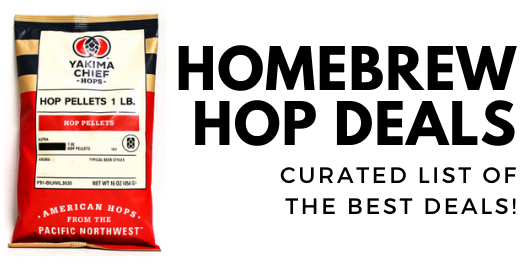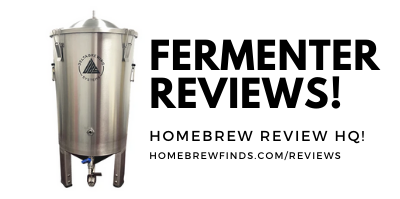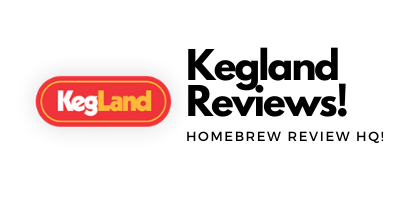
Hands on Review: Kegland Hop Bong!
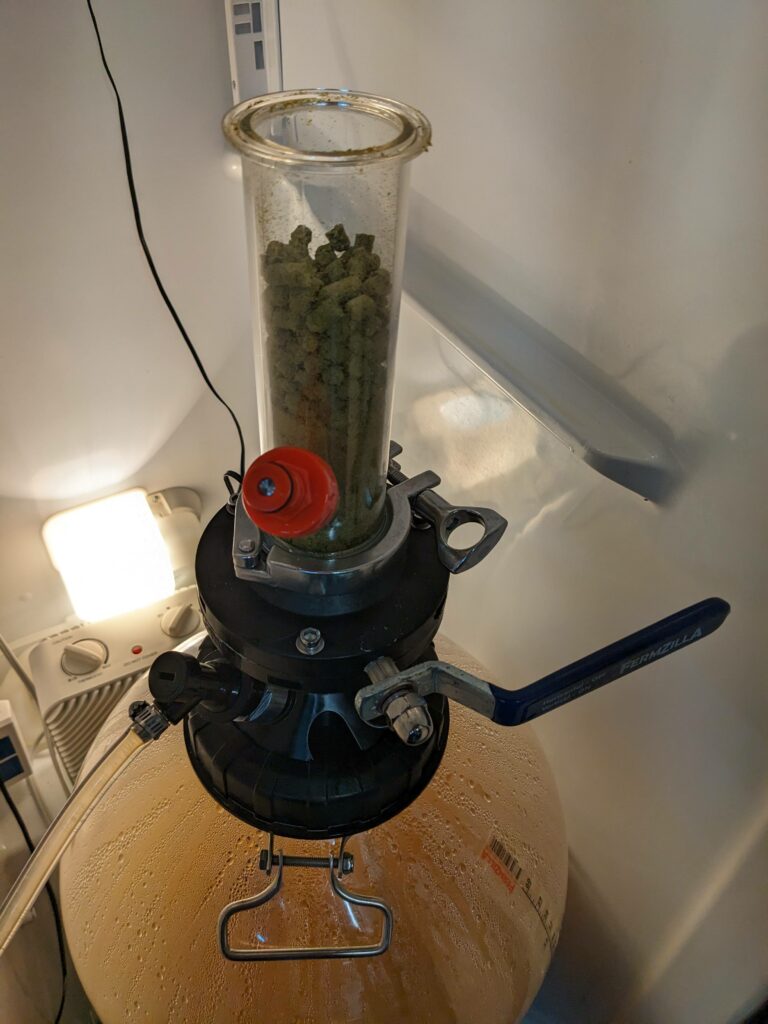
Updated: March 28, 2025
Thank you to HBF Contributor Aaron Nord for this hands on review! Aaron is an advanced award winning brewer, a long time reader and a serial tipster!
Kegland Hop Bong
Keeping oxygen out of a fermenter after the initial yeast pitch is a goal of most fermentations, with a few exceptions being oxygenating a high gravity batch mid-way through fermentation, barrel-aged ales, or spontaneously fermented ales in open foeders. For a homebrewer who wants to brew a beer outside of those exceptions noted, avoiding oxygen introduction after fermentation has begun is paramount to a quality finished beer, a goal which is sometimes a difficult to attain. Notably, adding dry hops, other flavor components (e.g. wood chips or coffee beans), or clarifying agents (e.g. gelatin fining or Biofine) presents a challenge for most homebrewers if they want to avoid oxygen exposure in the fermenting wort.
There are workarounds and ways for homebrewers to limit oxygen introduction, conceived upon by crafty brewers over the years. Dry hops for example, can be suspended in a muslin bag above the wort by placing a magnet inside the bag and its mating magnet on the outside of the fermenter. In this way, the hops will be in the fermenter at the beginning of fermentation and can be dropped according to the dry hop schedule by simply removing the outside magnet, all without opening the fermenter. Or, to add clarifying agents without cracking the fermenter lid, a brewer can utilize a plastic bottle with a carbonation cap. This method entails adding the liquid substance to a plastic soda bottle and pressurizing the bottle with CO2 via the carbonation cap, purging it, and repeating the process multiple times to ensure the gas inside the bottle is mostly composed of CO2. Then, by using a ball lock jumper, the pressurized bottle can be connected to a fermenter’s ball lock post, if equipped, and the liquid will enter the fermenter, so long as the pressure in the fermenter is less than that of the bottle.
Although these workarounds exist and cut the mustard for my purposes, I was excited when I found out that Kegland was set to release a product that appeared to be a simpler solution all around. In looking into it further I found that it was advertised to have additional uses, aside from the main feature of enabling hop, flavor, or fining additions to the fermenter while limiting oxygen ingress. This highly anticipated product is called the Hop Bong.
I have been a proud owner of a Kegland FermZilla All Rounder fermenter – Hands on Review – for over two years now and have nothing but good things to say about it. As a manufacturer, Kegland is a homebrewing gear innovator and a leader in the market. They are continuing to come up with novel equipment and tools that span their wide array of product offerings including many for their FermZilla fermenter line. I was excited to see what the Hop Bong could offer as an addition to my All Rounder fermenter.
Kegland Hop Bong Current Price & Availability:
via MoreBeer
- Hop Bong Upgrade Kit for FermZilla – 2 in. FE206
- Hop Bong Pressure Pack for FermZilla – 2 in. FE205
- All Hop Bong Options & Accessories
- All FermZilla Fermenters & Accessories
via William’s Brewing
- Hop Bong Upgrade for Fermzilla
- Hop Bong Pressure Pack for Fermzilla
- All Hop Bong Options & Accessories
- All FermZilla Fermenters & Accessories
This article contains affiliate links. We may make a small percentage if you use our links to make a purchase. You won’t pay more and you’ll be supporting Homebrew Finds and more content like this. Thank you for your support!
Related: FermZilla Reviews!
Related: Build a Dry Hopper for Cornelius Kegs!
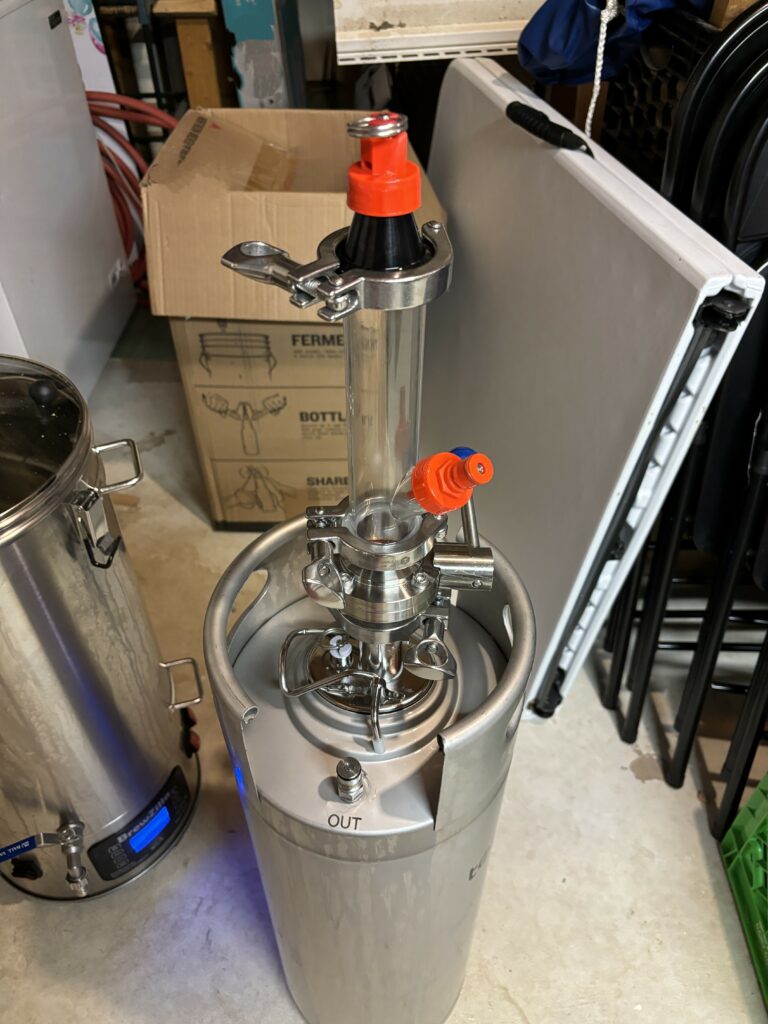 Building a Dry Hopper for Corny Kegs – Dry Hop Under Pressure!
Building a Dry Hopper for Corny Kegs – Dry Hop Under Pressure!
The Hop Bong kit has several components depending on which package a brewer chooses. MoreBeer has two kits which feature a 2 inch Hop Bong: one for existing FermZilla patrons and one that includes everything necessary for pressure fermentation, suited for those new to FermZilla. Kegland also offers a 1.5 inch Hop Bong, but it may not be available in the US as of this writing. The basic kit from MoreBeer is composed of the main chamber, called the Hop Bong, with 2 inch tri-clamp (T.C.) ends and an angled port threaded to receive a ball lock post, a cap that mates to the 2 inch T.C. top of the Hop Bong that has a pull-ring pressure-release valve (PRV) on the topmost part, a 2 inch tri-conical butterfly valve, and T.C. pressure lid. The pressure lid has a 2 inch T.C. top, an attached PRV similar to one on a corny keg, two threaded ports to attach ball lock posts, and a bottom that is the same size as the FermZilla fermenter lids.
Contents as listed by MoreBeer:
- FermZilla 2″ T.C. Pressure Lid Starter Kit
- 2″ Hop Bong
- 2″ FermZilla Tri-Conical Butterfly Valve
- Red PRV & PCO1881 Cap Combo
- Yellow Ball Lock Cap
- (2) Red Ball Lock Caps
- (2) 2″ Tri-Clamps
- (2) 2″ Silicone T.C. Gaskets
The upgrade kit comes with a floating dip tube with filter attachment.
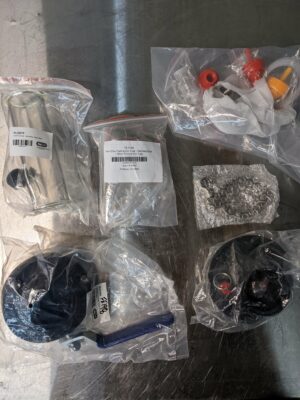
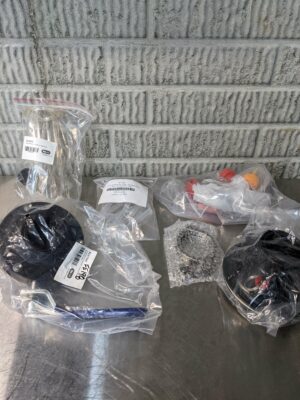
The Hop Bong itself is made of a high-grade polymer which can tolerate high temperatures. It is also capable of withstanding sanitization in an autoclave. It is completely transparent, allowing the monitoring of the contents quite easily. The size of the chamber is such that it can hold about six ounces or 180 grams of hops.
Kegland Hop Bong Components, Build Quality and Assembly
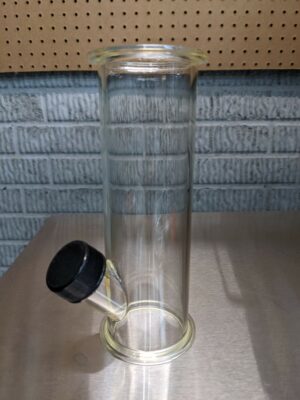 Hop Bong chamber side view
Hop Bong chamber side view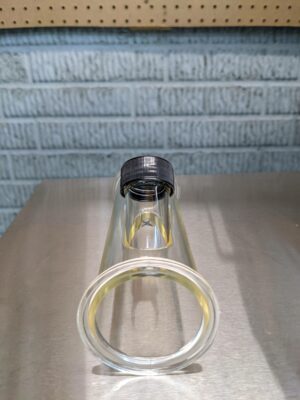 Hop Bong chamber bottom view
Hop Bong chamber bottom view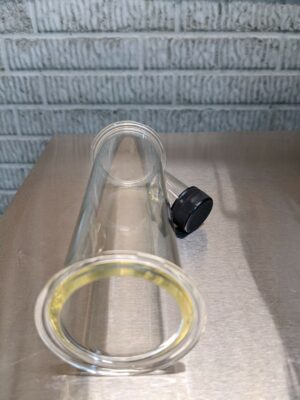 Hop Bong chamber top view
Hop Bong chamber top view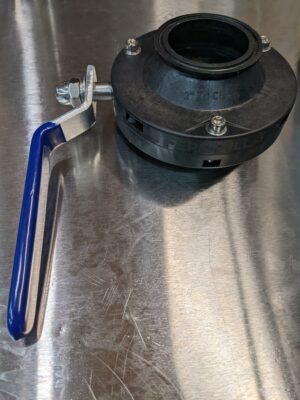
The butterfly valve is like those found on other FermZilla fermenters like their Tri-Conical. It has a solid action for opening and closing and makes an air-tight seal when closed.
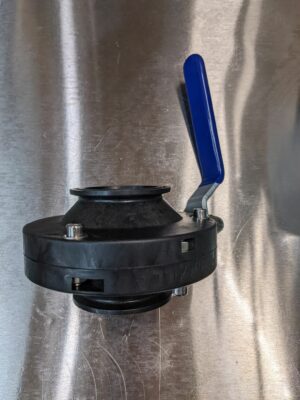 Butterfly valve on table side view open
Butterfly valve on table side view open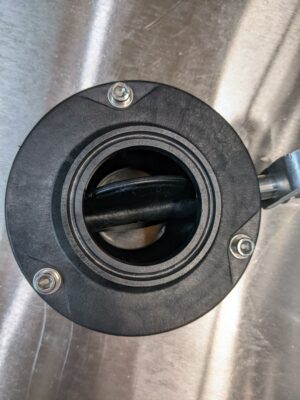 Butterfly valve on table top view open
Butterfly valve on table top view open
The tri-clamps are hefty and on the upper end of the quality scale compared to other tri-clamps I have handled. They are made of stainless steel. The silicone seals for the tri-clamp are also high grade.
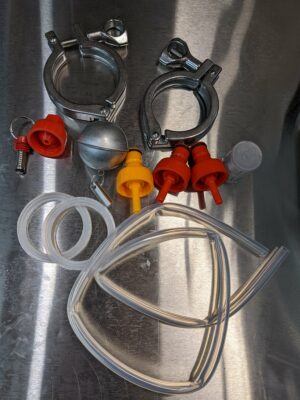 Carb caps tubing TCs gaskets and hose
Carb caps tubing TCs gaskets and hose
Overall, the quality of the materials is what I have come to expect from a Kegland product. It is well engineered and designed with the homebrewer in mind.
Also Features Kegland Carb Caps…
Hands on Review: Kegland Ball Lock Cleaning Kit and Party Pump
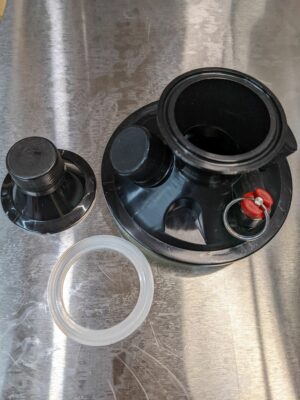 FermZilla lid and Hop Bong lid with gasket
FermZilla lid and Hop Bong lid with gasket
Assembling the Hop Bong was straightforward, and all pieces fit together as expected. Kegland has instructional videos on the Hop Bong which detail assembly and usage and, like their other videos, are clear, concise, and helpful.
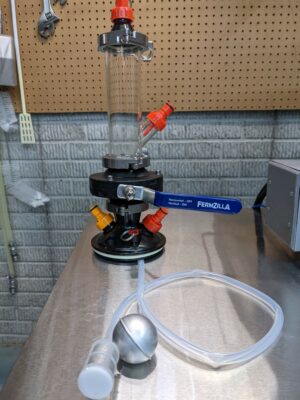 Assembled on table with dip tube
Assembled on table with dip tube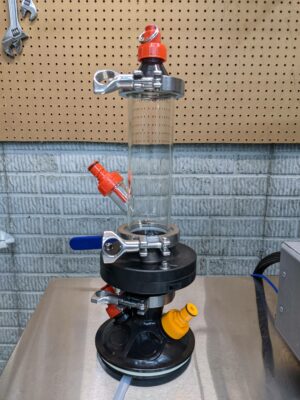 Assembled on table gas carb cap view
Assembled on table gas carb cap view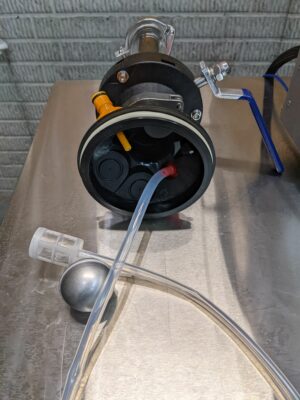 Assembled on table bottom view with dip tube
Assembled on table bottom view with dip tube
Uses for The Hop Bong
Although the main purpose of the Hop Bong is to deliver hops or various other mid/post-fermentation additions to a fermenting wort or finished beer, it can serve in other capacities as well. Outfitted with a carbonation stone, it can serve as either an in-line oxygenator or carbonator for wort/beer travelling through the chamber. This can be achieved by attaching the carbonation stone to the bottom of a carbonation cap which is then attached to the angled port on the Hop Bong’s main chamber. Then either end of the chamber is fitted with a cap and the cap is fitted with carbonation caps.
Another potential use is as a hop randall. Outfitted as described for oxygenation/carbonation minus the carbonation stone, the main chamber can be filled with hops (or other desired flavor components) and a finished beer can be pushed through the chamber, picking up flavors on its way through.
Hands on Review
The first chance I had to use my Hop Bong was on an Extra Special Bitter. Since I don’t typically add dry hops or any other flavor additions to this brew, I had to wait until the end of fermentation and subsequent cold crash for the gelatin fining addition. I started by preparing the solution and sanitizing the Hop Bong chamber and attached parts. Then, already having the cap off so I could sanitize the assembly, I simply poured the gelatin solution into the chamber. I replaced the lid, checked to make sure the silicone seal was in place, then tightened the tri-clamp. At this point I set my CO2 tank to 15 psi and attached the CO2 line to the carbonation cap on the Hop Bong. This filled the chamber with CO2 which I flushed by pulling on the PRV on the top cap of the Hop Bong. I repeated this process ten times to ensure that most of the oxygen had been replaced with CO2 in the chamber. I charged the chamber once more before turning the handle on the butterfly valve ninety degrees, dropping the gelatin solution into the All Rounder vessel. After I could see that all the solution had dropped, I moved the handle of the butterfly valve back into the closed position. Within thirty seconds, I had introduced nearly oxygen free gelatin finings into my fermented ESB, something I had only done previously with a workaround that was not ideal.
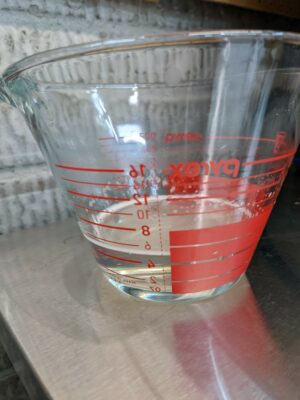 Gelatin finings volume
Gelatin finings volume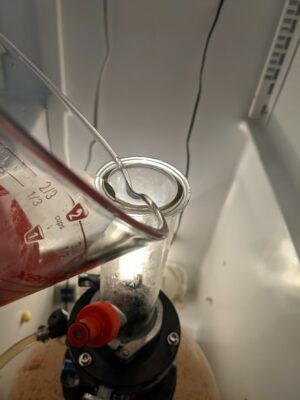 Gelatin finings being added into chamber
Gelatin finings being added into chamber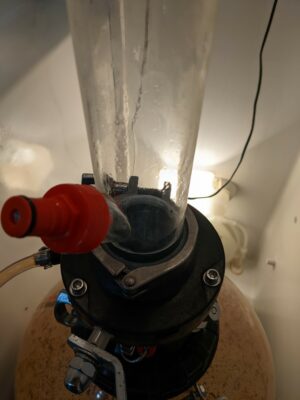 Gelatin finings in chamber before purge
Gelatin finings in chamber before purge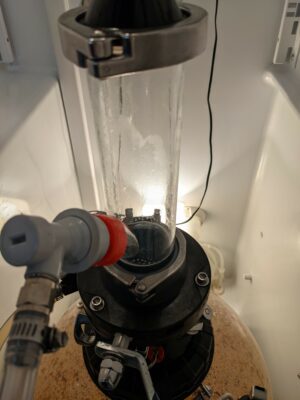 Gelatin finings in chamber adding CO2
Gelatin finings in chamber adding CO2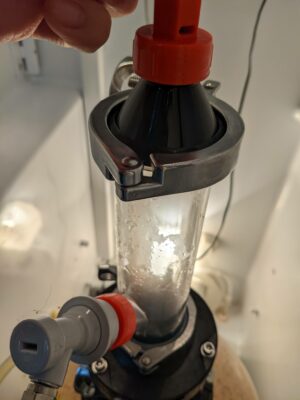 Gelatin finings in chamber purging CO2
Gelatin finings in chamber purging CO2
After this one simple use case I was already confident that I was going to enjoy using the Hop Bong going forward to perform other additions to my fermentations, all with the security of knowing I was keeping oxygen ingress to a minimum.
This first foray with the Hop Bong was pleasing for other reasons. It was a simple enough process that didn’t involve a bunch of cobbled together pieces – it all just worked from the box. The actions were all satisfying from pulling the PRV to the opening and closing movement of the butterfly valve. Cleanup was simple, since the Hop Bong itself is made of such hard, high-quality polymer it was easy enough to scrub with a cloth and brush in a bath of hot water and oxygen-based cleanser. The other parts were similarly cleaned, no different than many other common pieces of brewing equipment.
I was looking forward to my next chance to use the Hop Bong and wanted to test its main advertised use. There is a style of beer which typically includes dry hops I had not brewed before but wanted to try my hand at – an Italian pilsner. I put the recipe together and penciled the brew date in my calendar, being sure to include the dates of the two dry hop additions. Brew day went well and at the end I had eleven gallons of pilsner wort in my All Rounder fermenter being worked on by some happy lager yeast. At day six it was time to add the first dry hop addition, a small dose of only seven grams of Hallertauer Mittelfrueh. The process was like that of the gelatin fining addition mentioned previously where the charge was added to the Hop Bong chamber which was purged with CO2 ten times and then released into the main fermenter with the turn of the butterfly valve. The only difference was that this time I pushed more CO2 into the Hop Bong while the butterfly valve was open, encouraging any hop remnants that stuck to the Hop Bong walls (miniscule if any) down into the fermenter, being sure not to overcharge the main fermenter chamber with CO2. This process was repeated once again on day thirteen when 21 grams of Saphir hops were added in the same fashion and once again at the end of fermentation and cold crash for the gelatin finings.
The subsequent uses of the Hop Bong were just as satisfying as the first one. The Cold IPA I most recently brewed called for a couple of dry hop additions and one with 240 grams of hops. This addition was split into two cycles through the Hop Bong as it was just a bit too much for one fill of the chamber.
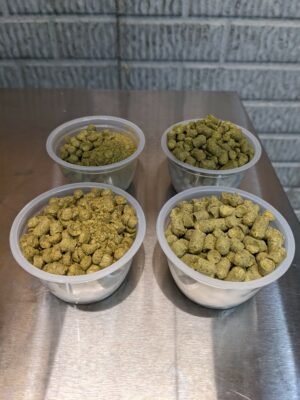 Cold IPA 240g Hop Additions
Cold IPA 240g Hop Additions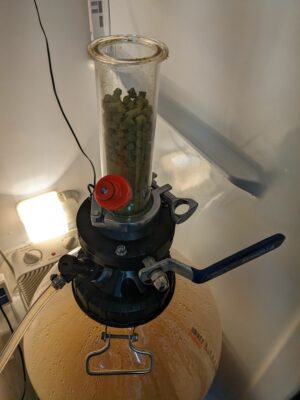 Cold IPA hops round 1
Cold IPA hops round 1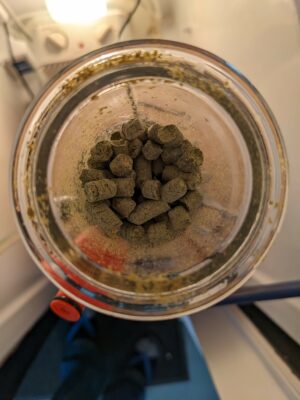 Cold IPA hops in open Hop Bong top view
Cold IPA hops in open Hop Bong top view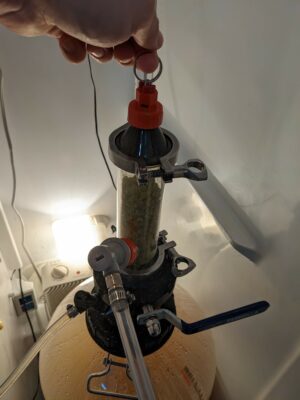 Cold IPA hops in closed Hop Bong purging CO2
Cold IPA hops in closed Hop Bong purging CO2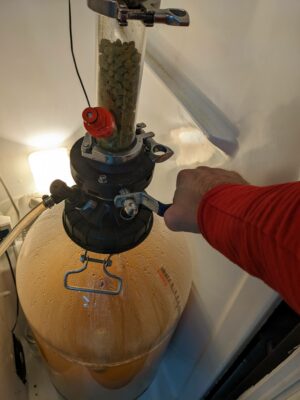 Cold IPA hops in closed Hop Bong before opening valve
Cold IPA hops in closed Hop Bong before opening valve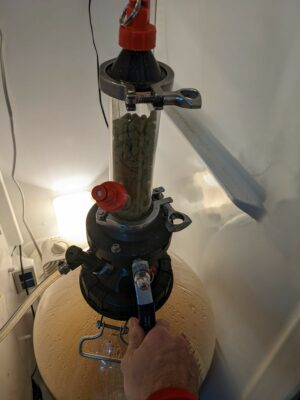 Cold IPA hops in closed Hop Bong while opening valve
Cold IPA hops in closed Hop Bong while opening valve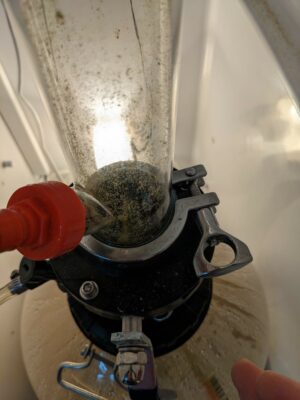 Cold IPA hops in closed Hop Bong after opening valve
Cold IPA hops in closed Hop Bong after opening valve
Having used the Hop Bong now several times I can say that it certainly fulfilled the exact purpose it was designed to achieve. It did this all while giving me a feeling of accomplishment in having dosed an actively fermenting wort with oxygen-purged ingredients in a manner not dissimilar to that a professional brewer might employ. Being able to keep that low-oxygen environment while adding those ingredients according to the recipe gets me one step closer to enjoying the idealized finished beer, one where there is a lower potential of off-flavors introduced by oxygen, a lower chance of staling quickly, and one that had those additions introduced on schedule without the use of some cobbled together homemade apparatus with a high potential for leaks or failure.
The only critiques I have of the Hop Bong have to do with how it fit with the fermenter itself. As stated previously, putting it all together was straightforward and every piece fit together well, but it was a bit awkward once the assembly was on top of the fermenter. Having the assembly on top of the fermenter made it a bit tricker to access the carbonation caps and thermowell on the fermenter lid, so tricky in fact that I did not get my spunding valve secured all the way on the carbonation cap the first time. This resulted in a spike in pressure before I was able to correct it. It was also more difficult to tighten the carbonation cap on the fermenter lid while the Hop Bong was attached as I had to maneuver my wrench around the Hop Bong. One other bit of awkwardness presented itself when turning the handle on the butterfly valve. The action of the valve itself was indeed solid. However, due to the torque I needed to apply to it for it to move freely, it tilted the Hop Bong assembly to the point I heard pressure escaping from the T.C. valve connection point between the bottom of the Hop Bong and the top of the fermenter lid. This could potentially have been remedied by tightening the T.C. clamp at that union, but I can see this as being a possible point of failure in the future and will monitor it going forward. Lastly, I would recommend putting the tightening ring on over the fermenter lid before putting the carbonation caps on, otherwise the caps will be too much of an obstruction.
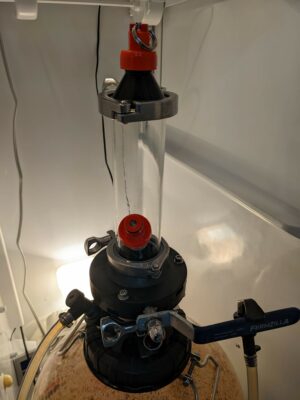 On FermZilla empty Hop Bong Chamber closed valve
On FermZilla empty Hop Bong Chamber closed valve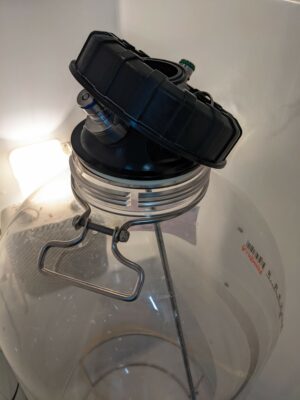 Tightening ring over carb caps on lid
Tightening ring over carb caps on lid
Summary
The Hop Bong is a strong addition to the FermZilla line of fermenters and one that makes me excited to look to the future to see what Kegland has coming down the pike. As usual with Kegland products, the components are well designed and made from high quality materials so it should last a long time. It gives me higher confidence in all my beers, but especially ones with multiple mid-fermentation additions, that they will be freer of flaws and age well over time. The Hop Bong is a must-have addition to any of the FermZilla fermenters and well worth the investment.
Kegland Hop Bong Current Price & Availability:
via MoreBeer
- Hop Bong Upgrade Kit for FermZilla – 2 in. FE206
- Hop Bong Pressure Pack for FermZilla – 2 in. FE205
- All Hop Bong Options & Accessories
- All FermZilla Fermenters & Accessories
via William’s Brewing
- Hop Bong Upgrade for Fermzilla
- Hop Bong Pressure Pack for Fermzilla
- All Hop Bong Options & Accessories
- All FermZilla Fermenters & Accessories
FermZilla Reviews!
Related: Build a Dry Hopper for Cornelius Kegs!
 Building a Dry Hopper for Corny Kegs – Dry Hop Under Pressure!
Building a Dry Hopper for Corny Kegs – Dry Hop Under Pressure!
More Photos
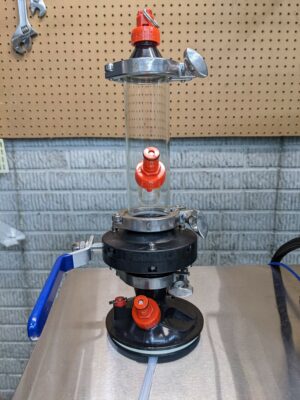 Assembled on table
Assembled on table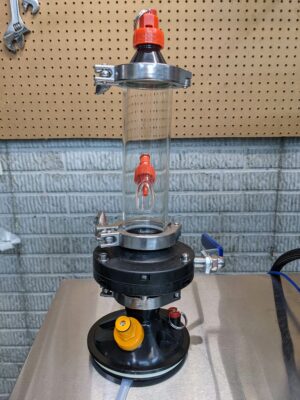 Assembled on table gas carb cap view
Assembled on table gas carb cap view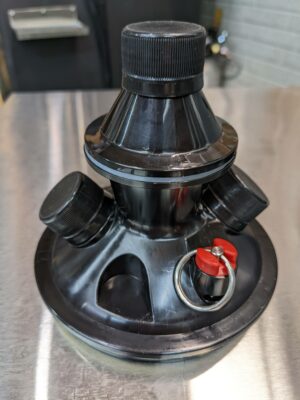 FermZilla lid and Hop Bong lid on top
FermZilla lid and Hop Bong lid on top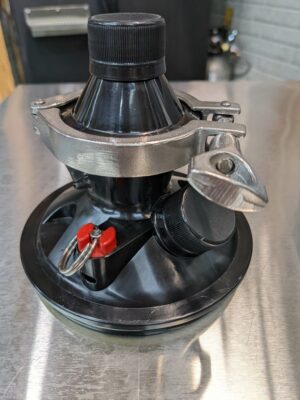 FermZilla lid and Hop Bong lid on top with TC
FermZilla lid and Hop Bong lid on top with TC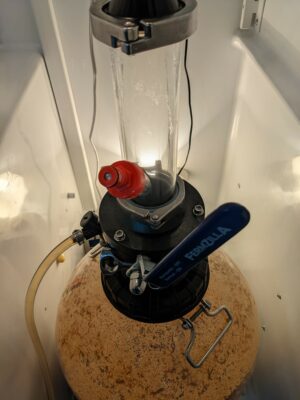 On FermZilla empty Hop Bong Chamber open valve
On FermZilla empty Hop Bong Chamber open valve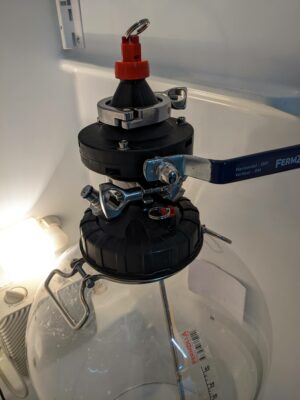 On FermZilla without Hop Bong Chamber
On FermZilla without Hop Bong Chamber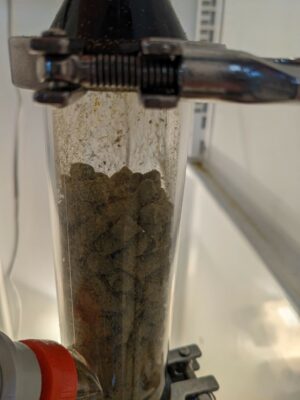 Cold IPA hops in closed Hop Bong close-up
Cold IPA hops in closed Hop Bong close-up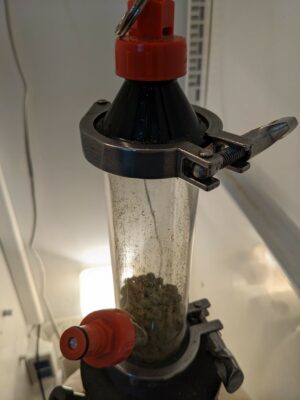 Cold IPA Hops in closed Hop Bong Round 2 close-up
Cold IPA Hops in closed Hop Bong Round 2 close-up
Recent Hop Deals!
Fermenter Reviews
More Kegland Gear Reviews!
More Homebrew Finds!
- Last 50 Finds!
- Top Deals – a curated list of the best deals
- Homebrew Reviews – one of the largest libraries of homebrew reviews in existence!
- Our Top Posts – tips, how-tos, resources posts and more
- Let’s be Friends!
Recent Deals!
10 Most Recent Homebrew Resource Posts & How-To’s!
We are Homebrew Review HQ! Our 10 Most Recent Reviews
pinnedThis post may contain affiliate links. We may make a commission when you use our links. This will never cost you extra. Thank you for supporting Homebrew Finds!
greatdealsPrice, promotions and availability can change quickly. Check the product page for current price, description and availability.
Make sure the components you use are compatible and rated for your intended application. Contact manufacturer with questions about suitability or a specific application. Always read and follow manufacturer directions
Thank you to MoreBeer for providing the units used for evaluation in this review.
Price, promotions and availability can change quickly. Check the product page for current price, description and availability. tag:lnksfxd review:klhb #tag:tpr
